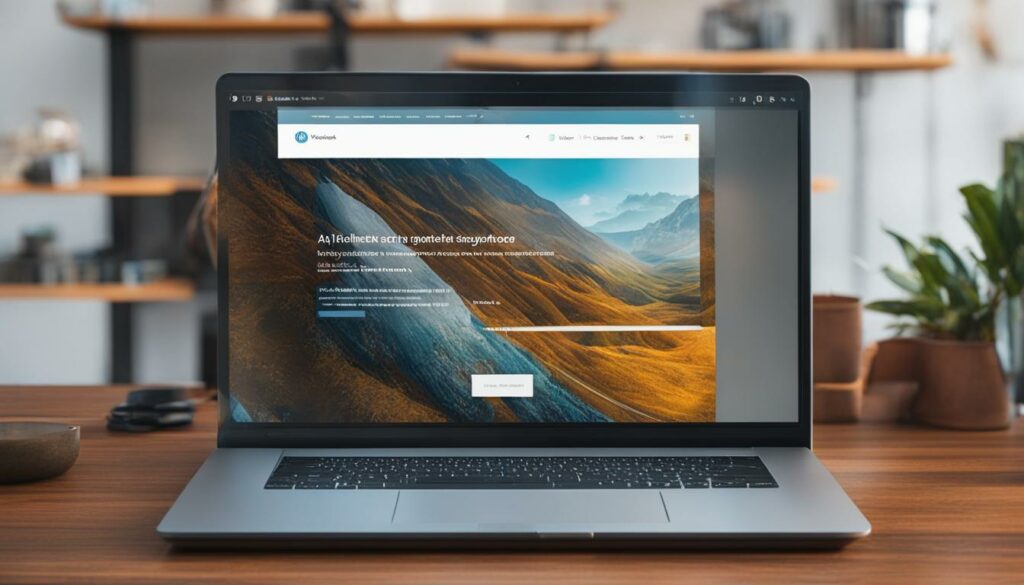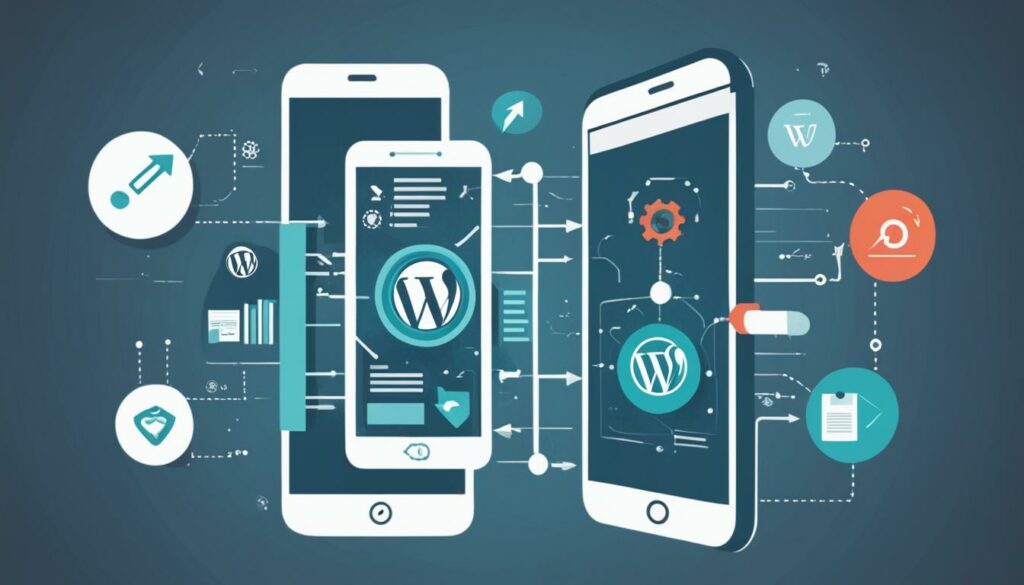In today’s mobile-driven world, it is crucial to ensure that your WordPress site is accessible to all users, regardless of their device or impairment. Mobile optimization and responsive design are key factors in creating a mobile-friendly WordPress website. By implementing mobile optimization techniques and utilizing WordPress plugins for mobile, you can enhance your site’s accessibility and user experience.
Best practices for WordPress mobile include designing a responsive WordPress theme that adapts seamlessly to different screen sizes and resolutions. This ensures that your site is easily navigable and content is legible on both desktop and mobile devices. Mobile SEO for WordPress is also essential for improving your site’s visibility and organic rankings on search engines.
In this comprehensive WordPress mobile optimization guide, we will delve into the importance of accessibility and provide practical tips to make your WordPress site mobile-friendly. Whether you’re a business owner, blogger, or developer, the insights and techniques shared here will help you create an inclusive online presence.
Key Takeaways:
- Mobile optimization is crucial for ensuring a smooth user experience on WordPress sites
- Responsive design and mobile SEO improve visibility and organic rankings on search engines
- WordPress plugins for mobile can enhance site functionality and accessibility
- Utilize best practices for WordPress mobile to create a mobile-friendly website
- Regularly test your WordPress site for mobile accessibility and make necessary improvements
Is WordPress accessibility-ready?
WordPress, as a popular content management system, recognizes the importance of web accessibility and has made efforts to prioritize it. The integration of WCAG 2.1 at level AA into the WordPress core demonstrates this commitment. However, it’s important to note that not all themes labeled as “Accessibility Ready” meet AA compliance standards. While WordPress provides guidelines and resources, the responsibility to ensure accessibility falls on the website owner.
Ensuring your WordPress site is accessible involves various considerations, including the selection of an appropriate theme and adherence to accessibility principles during the development process. Let’s explore the topic of WordPress accessibility readiness in more detail.
Understanding WCAG 2.1 and WordPress Accessibility
WCAG 2.1, developed by the World Wide Web Consortium (W3C), establishes guidelines for making web content more accessible to individuals with disabilities. WordPress acknowledges the significance of WCAG 2.1 conformance and encourages developers to create plugins and themes that align with these accessibility standards.
While WordPress itself strives to meet WCAG 2.1 at level AA, it’s essential to understand that not all themes in the WordPress theme repository achieve the same level of accessibility. Some themes marked as “Accessibility Ready” may fall short of the AA compliance standards set by WCAG 2.1. It’s crucial to perform thorough accessibility testing and evaluate themes individually to ensure they meet your site’s specific requirements.
Responsibility of Website Owners
As a website owner, the responsibility to ensure accessibility lies with you. While WordPress provides a solid foundation for accessibility, it’s your duty to select an appropriate theme and configure your site accordingly.
By choosing an Accessibility Ready theme, you can start with a solid foundation that aligns with WCAG 2.1 guidelines. However, it’s important to note that merely selecting an accessible theme doesn’t guarantee complete compliance. Customization, content creation, and plugin integration all play a role in the overall accessibility of your WordPress site.
Ultimately, improving accessibility requires a holistic approach that encompasses awareness, education, and continuous testing. By following best practices, choosing an appropriate theme, and diligently evaluating the accessibility of your site, you can ensure that your WordPress site complies with accessibility standards and accommodates all users.
| Key Points: | – WordPress expects code integrated into the ecosystem to conform to WCAG 2.1 at level AA |
|---|---|
| – Not all themes marked as “Accessibility Ready” meet AA compliance | |
| – The responsibility to ensure accessibility falls on the website owner |
Why WordPress Accessibility Matters
WordPress accessibility is not just a checkbox item; it plays a crucial role in creating an inclusive web environment. With over a billion people worldwide living with disabilities, ensuring the accessibility of your WordPress site becomes paramount in reaching and engaging this significant audience.
But accessibility is not only about accommodating disabilities. It also encourages better design practices, emphasizing simplicity, clarity, and user-friendly experiences. By prioritizing accessibility, you can enhance the overall user experience for all visitors, including non-native speakers and those with strong dialects.
Moreover, accessibility has a direct impact on your search engine ranking. Search engines like Google consider accessibility as a ranking signal, rewarding websites that prioritize inclusive design. By making your WordPress site accessible, you improve its visibility in search engine results pages, driving more organic traffic and potential conversions.
“Creating accessible websites is not just an ethical responsibility, but it also makes good business sense. Accessible design practices benefit all users, contributing to a positive user experience and fostering a more inclusive online community.”
However, the importance of WordPress accessibility goes beyond improving user experience and search engine ranking. Failing to ensure accessibility may result in legal consequences as well. In recent years, there has been a rise in ADA Title III lawsuits pertaining to digital accessibility. Websites that do not comply with accessibility standards may face legal action, potentially leading to significant financial penalties and reputational damage.
Remember, accessibility is not an afterthought; it is a fundamental requirement for any website, including those built on WordPress. By prioritizing WordPress accessibility, you enhance user experience, boost search engine visibility, and mitigate the risk of legal repercussions. So, don’t overlook the significance of accessibility; make it an integral part of your WordPress site’s design and development process.

Key Takeaways:
- WordPress accessibility is crucial for reaching a broad audience, including individuals with disabilities.
- Accessible design practices prioritize simplicity, clarity, and user-friendly experiences for all visitors.
- Search engines reward accessible websites with higher rankings, leading to increased visibility and organic traffic.
- Inaccessibility can result in ADA Title III lawsuits, leading to financial penalties and reputational damage.
- Make accessibility an integral part of your WordPress site’s design and development process to ensure a more inclusive online presence.
Key Elements of Web Accessibility
Web accessibility is a crucial aspect of ensuring that websites are usable and understandable for all individuals, including those with disabilities. To achieve this, there are four key elements that need to be considered: perceivability, operability, understandability, and robustness.
Perceivability
The first element of web accessibility is perceivability, which focuses on making information and user interface components accessible to all users. This includes providing alternatives for non-text content, such as images, through the use of alt-texts. Alt-texts are textual descriptions that can be read by screen readers, enabling individuals with visual impairments to understand the content of images. By implementing alt-texts, websites become more inclusive and ensure that visually impaired users can access and engage with the content.
Operability
Operability is the second element of web accessibility and aims to ensure ease of use for all users. This involves providing intuitive navigation, keyboard accessibility, and clear focus indicators. By enabling keyboard navigation, users who may have difficulty using a mouse can navigate the website using only their keyboard or other assistive technologies. Clear focus indicators, such as highlighted buttons or underlined links, help users understand their current location and navigate through the website more effectively.
Understandability
The third element of web accessibility is understandability, which involves presenting information and operation in a clear and straightforward manner. This includes using simple and concise language, organizing content in a logical structure, and providing contextual instructions. By ensuring that information is easily understandable, websites become more accessible to individuals with cognitive disabilities or those who are non-native speakers.
Robustness
The final element of web accessibility is robustness, which focuses on the compatibility of websites with different devices and assistive technologies. It is crucial to design websites that can adapt to various screen sizes and resolutions, ensuring that they are accessible on both desktop and mobile devices. Additionally, websites should be compatible with assistive technologies such as screen readers, magnifiers, and voice recognition software, enabling individuals with disabilities to access and interact with the content effectively.
By considering and implementing these key elements of web accessibility, websites can become more inclusive and provide equal access to all users, regardless of their disabilities. The next section will provide practical tips on how to make your WordPress site accessible, ensuring that you reach a wider audience and provide a better user experience for all.
How to Make Your WordPress Site Accessible
To ensure your WordPress site is accessible to a diverse range of users, it’s important to follow best practices and implement key accessibility features. Familiarize yourself with the Web Content Accessibility Guidelines (WCAG) provided by the World Wide Web Consortium (W3C) and the Web Accessibility Initiative (WAI). These guidelines outline the standards for creating accessible websites.
Here are some essential tips to make your WordPress site more accessible:
- Choose an Accessibility-Ready Theme: Select a theme from the WordPress theme repository that is labeled as “Accessibility Ready.” These themes are designed with accessibility in mind and often meet the WCAG guidelines.
- Install an Accessibility Plugin: Consider installing an accessibility plugin like WP Accessibility, which can help improve the accessibility of your site by adding features such as skip navigation links and keyboard navigation enhancements.
- Write Accessible Code: Follow coding best practices to ensure your website’s code is accessible. This includes using proper semantic markup, providing alternative text for images, and making sure your site is navigable using a keyboard.
- Add Captions and Transcripts: Include captions and transcripts for images, GIFs, and videos. This enables users with visual impairments or those using screen readers to understand the content.
- Ensure Keyboard Navigation: Make sure your site can be easily navigated using the keyboard alone, without relying on mouse or touch inputs. This is important for users who have motor disabilities.
- Choose Accessible Colors and Fonts: Use color combinations with adequate contrast to ensure readability for users with visual impairments. Also, select fonts that are easy to read and resizable for users with different abilities.
- Create Accessible Content: Write your content in a clear and easy-to-understand manner. Use headings, lists, and paragraphs appropriately to improve readability and organization.
- Avoid Auto-Playing Videos: Auto-playing videos can be distracting and disruptive, especially for users who rely on screen readers or who have cognitive impairments. Provide controls for users to manually play or pause videos.
- Use Clear and Simple Layouts: Keep your website’s layout clean and simple to enhance usability. Avoid cluttered designs and excessive animations that can overwhelm users and make it difficult for them to navigate.
- Regularly Test for Accessibility: Regularly test your website for accessibility using automated tools and manual testing methods. This will help you identify and address any accessibility issues that may arise.
By following these WordPress accessibility tips, you can create an inclusive and user-friendly website that is accessible to all users, regardless of their abilities.

WordPress Accessibility Tips
| Accessibility Feature | Description |
|---|---|
| Accessibility-Ready Theme | Choose a theme from the WordPress repository labeled as “Accessibility Ready” to ensure it meets accessibility standards. |
| Accessibility Plugin | Install an accessibility plugin like WP Accessibility to enhance the accessibility features of your site. |
| Accessible Code | Follow coding best practices to ensure your website’s code is accessible, including using proper markup and alternative text for images. |
| Image Captions and Transcripts | Include captions and transcripts for images, GIFs, and videos to make the content accessible to users with visual impairments. |
| Keyboard Navigation | Ensure your site can be navigated using the keyboard alone, providing accessibility for users with motor disabilities. |
| Accessible Colors and Fonts | Choose color combinations with adequate contrast and fonts that are easy to read to improve readability for users with visual impairments. |
| Accessible Content | Write clear and easy-to-understand content, using appropriate headings, lists, and paragraphs to enhance readability and organization. |
| Auto-Playing Videos | Avoid auto-playing videos, as they can be distracting and disruptive to users with cognitive impairments. |
| Clear and Simple Layouts | Keep your website’s layout clean and simple to enhance usability, avoiding cluttered designs and excessive animations. |
| Accessibility Testing | Regularly test your website for accessibility using automated tools and manual testing methods to identify and address any issues. |
Is WordPress accessible out of the box?
WordPress has made significant strides in improving accessibility, thanks to the dedicated efforts of the WordPress accessibility team. The team ensures that officially bundled WordPress themes are evaluated for accessibility against the WordPress Accessibility Coding Standards. However, it is important to note that there are still some accessibility issues within WordPress, particularly with the Gutenberg editor.
The Gutenberg editor, introduced in WordPress version 5.0, has faced criticism for its accessibility shortcomings. While efforts are being made to address these issues, it is crucial for website owners to be aware of the potential accessibility barriers that may arise when using the Gutenberg editor.
Fortunately, there are accessible themes available in the WordPress theme repository that can help address potential accessibility concerns. Additionally, reputable paid theme providers also offer accessible WordPress themes that adhere to accessibility standards. However, it is important to thoroughly test and verify the accessibility of any theme before incorporating it into your WordPress site.
Gutenberg Accessibility Concerns
The Gutenberg editor, which introduced a block-based approach to content creation, has faced criticism for its accessibility shortcomings. The concern lies in the lack of proper accessibility coding practices within some of the blocks available in Gutenberg.
While progress is being made to improve Gutenberg’s accessibility, it is crucial to remain cautious when using this editor and to consider the potential impact on the overall accessibility of your WordPress site.

Accessible WordPress Themes
When choosing a theme for your WordPress site, it is essential to prioritize accessibility. The WordPress theme repository offers a wide selection of accessible themes that have been evaluated against the WordPress Accessibility Coding Standards. These themes provide a solid foundation for building an inclusive website.
In addition to the themes available in the WordPress theme repository, there are reputable paid theme providers that offer accessible WordPress themes. These themes are specifically designed to meet accessibility standards and can be a great option for website owners looking for additional customization and features.
However, it is important to note that not all paid themes guarantee accessibility. It is always recommended to test and verify the accessibility of any theme you choose, regardless of whether it is from the WordPress theme repository or a paid provider.
Comparison of Accessible WordPress Themes
| Theme | Accessibility Features | Price |
|---|---|---|
| Theme A | High contrast colors, keyboard navigation support | $49 |
| Theme B | Accessible typography, image alt-text support | $69 |
| Theme C | Semantic HTML markup, screen reader compatibility | $79 |
As you can see from the table above, accessible WordPress themes offer a range of features that contribute to the overall accessibility of your website. The pricing of these themes may vary depending on the provider and the specific features they include. It is important to carefully review the accessibility features and pricing before making a decision.
Remember that accessibility is a continuous effort, and it is crucial to regularly test and audit your website for accessibility issues. By prioritizing accessibility and choosing the right theme, you can ensure a more inclusive and user-friendly experience for all visitors to your WordPress site.
Selecting and Building an Accessible Theme
When it comes to creating an inclusive and user-friendly website, selecting an accessible theme is crucial. Thankfully, WordPress offers several options that prioritize accessibility, catering to a diverse range of users. Here, we’ll explore different approaches to finding the right accessible theme for your WordPress site, be it from the WordPress theme repository or through building a custom theme.
Choosing an Accessible Theme
If you’re looking for a ready-made solution, the WordPress theme repository is a great place to start. It offers a wide selection of accessibility-ready themes designed to comply with web accessibility standards. These themes have been evaluated to ensure they meet the necessary criteria, making them a reliable choice for accessibility-conscious website owners.
However, it’s important to conduct independent testing and verify a theme’s accessibility claims. While themes labeled as “Accessibility Ready” in the repository aim for compliance, they may not always meet all the requirements of WCAG 2.1. Therefore, testing the theme’s accessibility is crucial to ensure a seamless user experience for all visitors.
If you’re unable to find an accessible theme that suits your specific needs from the repository, consider exploring commercial themes. Reputable commercial theme providers often prioritize accessibility and offer a range of themes designed with accessibility in mind. When opting for a commercial theme, do your research and choose a provider with a track record of prioritizing accessibility.
Building an Accessible Custom Theme
If you’re seeking greater control over the accessibility features of your WordPress site, building a custom theme may be the best option. Building a theme from scratch allows you to implement specific accessibility requirements tailored to your website’s unique needs.
When building a custom theme, pay special attention to key accessibility considerations such as color contrast. Adequate color contrast ensures that text is easily readable by individuals with visual impairments. Be sure to follow the Web Content Accessibility Guidelines (WCAG) for color contrast ratios.
Additionally, consider other accessibility best practices such as providing alternative text for images, ensuring keyboard navigation, and using accessible fonts. By incorporating these accessibility features into your custom theme, you can create a website that is truly inclusive and accessible to all users.
Remember, regardless of whether you choose an accessible theme from the repository or build a custom theme, always prioritize the accessibility needs of your audience. By putting accessibility at the forefront, you can ensure that your WordPress site is inclusive and enjoyable for all visitors.
Note: The image above depicts the process of selecting and building an accessible theme for your WordPress site.
**Table: Pros and Cons of Selecting vs. Building an Accessible Theme**
| | Selecting an Accessible Theme | Building an Accessible Custom Theme |
| — | — | — |
| **Pros** | – Wide selection in the WordPress theme repository
– Evaluated for accessibility compliance
– Saves time and effort | – Greater control over accessibility features
– Tailored to specific website needs
– Can implement custom accessibility requirements |
| **Cons** | – Theme may not fully meet accessibility standards
– Requires independent testing | – Higher development time and cost
– Requires advanced knowledge of theme development and accessibility guidelines |
Importance of Alt-texts for Accessibility
When it comes to web accessibility, alt-texts play a crucial role in ensuring that images are accessible to individuals with visual impairments or who use screen readers. Alt-texts, also known as alternative text, provide a textual description of the images, allowing users to understand and interact with the content.
Alt-texts are not only important for visually impaired individuals but also for search engine optimization (SEO). By including descriptive alt-texts that accurately represent the content of the images, you improve image visibility and discoverability in search engine results.
Moreover, alt-texts adhere to the Web Content Accessibility Guidelines (WCAG) which outline best practices for accessible web design. Following these guidelines ensures that your website meets the standards for accessibility, making it easier for individuals with visual impairments to navigate and understand your content.
When implementing alt-texts, remember that they also serve as a fallback when images fail to load. In such cases, the alt-text provides context about the missing image to ensure a seamless user experience.
Why Alt-texts are important:
- Allows individuals with visual impairments to understand the content of images
- Improves image visibility and discoverability for search engine optimization
- Ensures compliance with WCAG accessibility guidelines
- Serves as a fallback option when images fail to load
| Alt-text best practices | Mistakes to avoid |
|---|---|
| Be descriptive and accurately depict the image | Avoid using generic alt-text like “image” or “picture” |
| Keep alt-text concise and within 125 characters | Avoid lengthy alt-text that may overwhelm screen reader users |
| Include keywords related to the image and the surrounding content | Avoid keyword stuffing in alt-text, as it may result in a poor user experience |
| Ensure alt-text provides meaningful information about the image | Avoid vague or uninformative alt-text that doesn’t add value |
By prioritizing the inclusion of alt-texts for your website’s images, you are not only enhancing web accessibility for individuals with visual impairments but also optimizing your content for search engines. Remember to follow best practices and avoid common mistakes to ensure your alt-texts are effective and provide value to all users.
Common myths about WordPress accessibility
When it comes to WordPress accessibility, there are several common myths that often circulate. It’s important to debunk these misconceptions to ensure a better understanding of the topic and its impact. Let’s take a closer look at some of these myths:
Myth 1: Accessibility is only for visually impaired users
A common misconception is that accessibility is solely focused on catering to visually impaired users. While visually impaired users are an important demographic, web accessibility goes beyond just visual impairments. It encompasses a wide range of disabilities, such as mobility impairments, cognitive impairments, and hearing impairments. Ensuring accessibility means making websites usable and understandable for everyone, regardless of their abilities.
Myth 2: One-click accessibility plugins provide comprehensive accessibility
One-click accessibility plugins can be helpful in adding some accessibility features to a WordPress site. However, it’s crucial to understand that these plugins are not a one-size-fits-all solution and may not provide comprehensive accessibility. They often focus on common accessibility issues but may not address specific needs or meet all the requirements of different user groups. To ensure full accessibility, it’s recommended to follow best practices, use proper coding techniques, and consider the specific needs of your target audience.
Myth 3: Web accessibility is not important or relevant
Web accessibility is not just a luxury; it is a fundamental human right. Digital rights for disabled individuals are becoming increasingly recognized and emphasized globally. With the growing importance of the internet in our daily lives, inaccessible websites can create barriers, preventing disabled individuals from accessing information, services, and opportunities. Moreover, many countries have enacted legislation, such as the Americans with Disabilities Act (ADA), which mandates accessibility for certain websites. Ignoring web accessibility can not only limit your audience but also expose you to legal risks.
It’s essential to debunk these myths and recognize the growing importance of web accessibility. Creating an inclusive online environment is not only the right thing to do but also beneficial for both users and website owners. By considering the needs of disabled individuals and implementing accessible design practices, you can ensure a better user experience for all visitors to your WordPress site.
| Myth | Reality |
|---|---|
| Accessibility is only for visually impaired users | Web accessibility encompasses a wide range of disabilities, not just visual impairments. |
| One-click accessibility plugins provide comprehensive accessibility | While helpful, these plugins may not meet all accessibility requirements and address specific needs. |
| Web accessibility is not important or relevant | Web accessibility is a fundamental human right and has legal implications. |
Conclusion
Website accessibility is crucial for reaching a broader audience, enhancing user experience, and adhering to legal obligations. While WordPress offers guidelines and resources, the responsibility lies with website owners to prioritize and implement accessibility measures. By adopting best practices, utilizing accessible themes and plugins, and regularly testing for accessibility, WordPress sites can become more inclusive and user-friendly.
Ensuring website accessibility allows you to expand your reach by accommodating individuals with disabilities, who comprise a significant portion of the global population. Furthermore, accessible design principles promote better user experience for all visitors. It’s worth noting that search engines like Google consider accessibility as a ranking factor, further emphasizing its importance.
Although WordPress provides a foundation for accessibility, it is crucial to remember that not all themes labeled as “Accessibility Ready” comply with the required standards. Therefore, it’s essential to choose themes carefully and test them independently. Additionally, optimizing images with descriptive alt-texts, implementing keyboard navigation, and using accessible colors and fonts are vital steps towards creating a more inclusive website.
In summary, prioritizing website accessibility through best practices and the utilization of accessible themes and plugins is key. By continuously testing for accessibility and making necessary improvements, you can create a more user-friendly and inclusive WordPress site that not only complies with legal requirements, but also attracts a wider audience and enhances the overall user experience.
FAQ
Q: Is WordPress accessibility-ready?
A: WordPress expects code integrated into the ecosystem to conform to WCAG 2.1 at level AA, but not all “Accessibility Ready” themes in the repository meet AA compliance.
Q: Why does WordPress accessibility matter?
A: WordPress accessibility is essential for reaching a wider audience, improving user experience, and complying with legal requirements. It also helps with search engine ranking and reduces the risk of ADA Title III lawsuits.
Q: What are the key elements of web accessibility?
A: Web accessibility involves perceivability, operability, understandability, and robustness.
Q: How can I make my WordPress site accessible?
A: Familiarize yourself with accessibility guidelines, use an accessibility-ready theme, install an accessibility plugin, ensure your code follows best practices, add captions and transcripts for multimedia content, make your site keyboard navigable, choose accessible colors and fonts, and regularly test your site for accessibility.
Q: Is WordPress accessible out of the box?
A: Officially bundled WordPress themes are evaluated for accessibility, but there are still accessibility issues within WordPress, especially with the Gutenberg editor. It is important to test and verify the accessibility of any theme before using it.
Q: How can I select and build an accessible theme?
A: Consider using accessibility-ready themes from the WordPress theme repository or reputable commercial themes. However, it is important to conduct independent testing to ensure accessibility. Building a custom theme provides more control over accessibility but requires attention to details such as color contrast.
Q: Why are alt-texts important for accessibility?
A: Alt-texts provide textual descriptions of images for those with visual impairments or using screen readers. They meet WCAG guidelines and improve image visibility and discoverability for search engine optimization.
Q: What are some common myths about WordPress accessibility?
A: Some common myths include the misconception that accessibility is only for visually impaired users and that one-click accessibility plugins provide full functionality. Web accessibility is a crucial human right for disabled individuals, and its importance is growing in the digital world.












